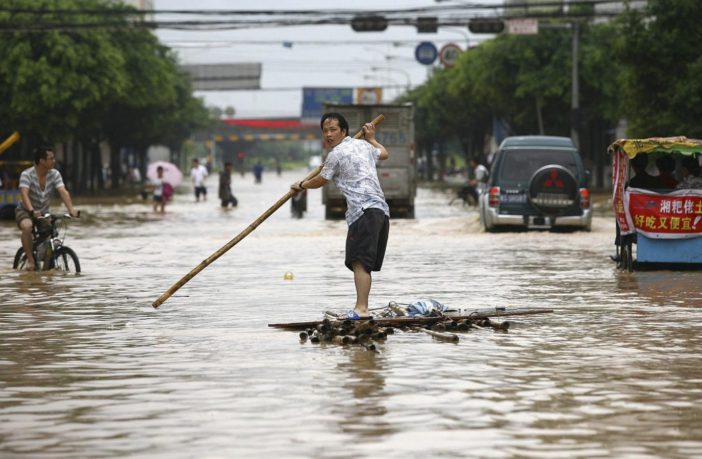A study by a team from the Open University (OU) has had its findings published in leading science journal Nature Communications
Findings at a glance
- Study shows that the long-term evolution of East Asian Monsoon rainfall was driven by the rising Himalayas, but Indian Monsoon rainfall is sensitive to a complex mix of drivers, with significant roles of atmospheric CO2 and ice-sheet state.
- Competing effects of CO2 and ice sheets on Indian Summer Monsoon rainfall has been observed in the geological past with implications for the future rainfall intensity.
- Sensitivity of Indian Monsoon rainfall to human CO2 emissions is likely to be comparable to the scale of the historical variations due to all the forcing factors considered for the past 30 million years.
By disentangling the roles of different drivers, the authors were able to directly compare the contribution of CO2 relative to other factors. In their model, doubling atmospheric CO2 concentration from its preindustrial level to 560ppm produced increases in Indian Summer Monsoon rainfall that were greater than any changes simulated by the model in response to multiple drivers acting together over the last 30 million years. Given that global CO2 levels today are already in excess of 415ppm, avoiding the risk of changes to monsoon rainfall beyond anything the Earth has experienced for many millions of years therefore demands urgent action to curtail CO2 emissions.
The Asian monsoons are amongst the large-scale features of Earth’s climate of greatest significance to human society, impacting on the lives of more than a third of humanity, and yet their dynamics are still far from fully understood. A study by trans-disciplinary researchers from The Open University (OU) has revealed new insights into the sensitivity of these monsoons to changes in tectonic and climatic factors. The study shows how the East Asian and Indian Monsoon rainfall amount has evolved in the geological past in response to tectonic and climate influences, millions of years ago.
This OU led project, including Dr Jim Thomson, Dr Phil Holden, Dr Pallavi Anand, Ms Cecile Porchier, Professor Neil Edwards and Professor Nigel Harris, is the first detailed evaluation of tectonic and climatic influences of Asian monsoon rainfall, revealing Indian and East Asian Monsoon rainfall were controlled by different factors in the past. The paper, Tectonic and climatic drivers of the Asian monsoon evolution, is published in Nature communications (29th June 2021).
Dr Thomson said:
“The study used a quarter of a million data points of changes to the major climate drivers over the last 30 million years to calculate how monsoon rainfall has varied. This was done separately for India and South-East Asia. The achieved level of detail of rainfall changes has never been possible before. The results aid judgments about the future effects of rising CO2 levels.”
Dr Holden said:
“Although these different drivers have all been modelled separately before, it’s never been possible to study how they work together because of the huge computing requirements. We used a statistical approach called emulation to get around this.”
Previous modelling studies have carried out snapshot simulations that typically consider one or two forcing factors and their effects on rainfall over a narrow time window. In contrast, this new study considers eight forcing factors together using a few hundred simulations with a low-resolution ocean-atmosphere General Circulation Model to derive statistical models for the Indian and South East Asian monsoons. These models were applied to reconstruct rainfall for the past 30 million years at exceptionally high temporal resolution (1000 years) and to quantify the relative significance of the different drivers in controlling annual rainfall which is dominant in summer months, explained Dr Holden.
Dr Anand said:
“We were curious to find out how monsoon rainfall responded to multiple tectonic and climatic factors, often operating simultaneously in the geological past. Surprisingly, results show that the Indian monsoon rainfall amount is sensitive to multiple climatic drivers in the past, particularly CO2 and ice sheets changes which are also very relevant for the future monsoon.”
Further validation of findings that the ice-sheet and CO2 have competing effect on Indian monsoon rainfall is needed through proxy-based rainfall reconstructions during the Pliocene and Miocene. To study these geological time intervals, continuous sediment archives such as long cores obtained from the International Ocean Discovery Programme are necessary, Dr Anand added.
Prof Harris said:
“What really surprised me about the results from this study is that they overturn the widely-held assumption that the Indian monsoon is almost entirely the result of the uplift of Tibet and the Himalayas and provide a strong indication that the rise of these mountains is only one of several important factors. For example the impact of closing the Panama gateway on the Indian monsoon is a fascinating example of how elements of the Earth’s climate may be influenced by factors many thousands of miles away”.
Prof Edwards continues:
“Our emulator-based sensitivity study represents the equivalent of over 5000 million years of climate simulation, more than the age of the Earth. Effectively we have modelled the past 30 million years to estimate how much the Asian monsoons might change in the near future”
The OU researchers acknowledge funding support through National Environment Research Council (NERC).
The next steps are to integrate their modelling results with proxy data and to explore the sensitivity of their findings to modelling uncertainties.



